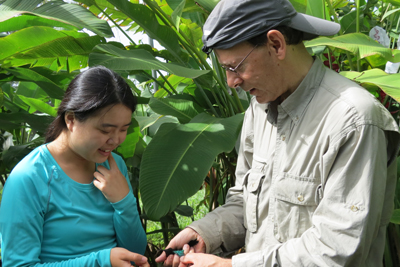By Peter Rooney
In a jungle-like enclosure the size of a basketball court on one of the Caribbean’s most ecologically diverse islands, Ethan Temeles, Amherst College's Thomas B. Walton Jr. Memorial Professor of Biology, has devised an audacious experiment he hopes will help answer one of evolution’s most vexing questions once and for all.

The question is this: Why do bird species, in this case hummingbirds, select certain flowers to pollinate, and how do such decisions influence the evolution of both bird and flower?
Temeles already has made significant progress toward answering that question. In a 2003 article that appeared in Science, Temeles and colleague W. John Kress of the Smithsonian Institution reported that the shape and length of the bill of the female purple-throated carib hummingbird has evolved differently from the bill of the male, to better fit the flowers that provide the birds with nectar. At the same time, the flowers of their two Heliconia food plants have adapted to the bills of the birds that are their means of reproduction.
“My studies of the purple-throated carib hummingbird provide the strongest evidence to date for Darwin’s ecological causation hypothesis, by linking sexual differences in trophic morphology to sexual differences in resource use,” Temelesy said.
Now, aided by a recently announced $139,000 grant from the National Science Foundation, Temeles will have the resources to continue his hummingbird research on the island of Dominica for at least the next five years. Not only that, a minimum of 10 Amherst students, as well as residents from Dominica with an interest in science, will assist him in his research, and potentially be co-authors on forthcoming papers.
“This is my 16th year going to the Caribbean, and I’ve been joined by Amherst students every year,” Temeles said. “I believe there have been 17 publications out of all of this work, with 16 Amherst students as co-authors.”
The enclosed space that Temeles has painstakingly created and maintained over the past nine years, with the help of Kress and a greenhouse manager from the Smithsonian Institution (where colleague Kress is a research botanist and curator), will allow him and his students to closely monitor and observe bird behavior to see whether, as is strongly suspected, competition between male and female hummingbirds plays a key role in determining which flowers end up getting pollinated, and by whom.
“The idea is that male and female hummingbirds are very different in size, and then we see them differ in their visits to the yellow- and red-colored flowers that they pollinate,” Temeles said. “Is that a result of preference or competition? What we’ve found in our initial pilot studies is that it’s competition. The males take the colored flowers they want, and they push females off of them.”
The male has an easy time doing this, Temeles said, because it’s one of the largest hummingbirds in the world.
“It’s about the size of a chickadee, and a bit of a bully,” he said. “It pushes the females off the plants it wants, and the females then go on to other plants.”
Indeed, this species of hummingbird exhibits some of the most pronounced sexual dimorphisms in bill size and shape of any avian species. Males are 25 percent heavier than females, yet the bills of females are 20 percent longer and 40 percent more curved.
Although field observations by Temeles and others strongly suggest it, the only way to scientifically test the hypothesis that competition plays a key role in determining which flowers end up getting pollinated would be to provide male and female hummingbirds access to flowers without interference from each other before setting them loose at the flowers together.
“Being a good scientist means that you have to try to show what you think is happening in the field through a process that can be carefully observed and demonstrated,” Temeles said.
And that’s exactly what Temeles and his research group has done, with an enclosed garden that contains 70 plants with a total of 400 flowering stalks available for the birds to visit, drink nectar from and pollinate. Peer-reviewed results haven’t been published yet, because Temeles and his group can only observe five pairs of birds each summer, and are only in second summer of this project.
Enclosed garden
“Nobody’s ever tried anything like this before, and we want to have a body of data that we feel confident about before we publish,” Temeles said. “The enclosed garden concept is pretty radical, really. When we started building it nine years ago, my feeling was that this is something that will work very well or be a complete failure. There’s not really a middle road.”
However, Temeles said building the garden was a risk worth taking, and not only because of the recognition that would likely come from shedding more light on Charles Darwin’s theories regarding natural selection.
“The more attention these beautiful hummingbirds receive, the more they will become beloved creatures that people want to see,” Temeles said. “My hope is that my hummingbird research can help Dominica remain the most natural island of the Caribbean, and bring in more resources to help conserve its resources and species.”
NOTE: A PBS Nature documentary titled Hummingbirds: Magic in the Air features Temeles’ research on the purple-throated carib hummingbird on Dominica (at about the 12:20 mark). The film is spectacular for its high-speed cinematography: viewers can literally see hummingbirds trying to kick each other as they squabble over food and get birds’-eye views of them feeding from flowers.